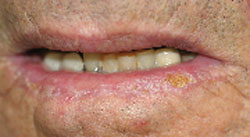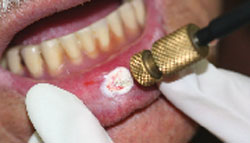
Am Fam Physician. 2008;77(8):1078-1079
Author disclosure: Nothing to disclose.
Original Article: Treatment Options for Actinic Keratoses
Issue Date: September 1, 2007
Available at: https://www.aafp.org/afp/20070901/667.html
to the editor: The article in American Family Physician is a comprehensive review of the available therapeutic options for patients with actinic keratoses. Although the article illustrates useful recommendations for actinic keratoses, we would like to make some clarifications and suggest further treatments.
Actinic cheilitis is a clinical variant of actinic keratoses developing typically on the lower lip (the more sunexposed area), which has a greater risk of progression to invasive squamous cell carcinoma compared with normal skin.1 Early actinic, keratotic lesions of the lips may have a rough contour and/or appear slightly white (milky discoloration). More advanced lesions appear erythematous, thickened, and may show fissuring, scaliness, or ulcerations (Figure 1A) with loss of the vermilion border.1 Any suspicious thickened, ulcerated, or cryotherapy-resistant lesions should be biopsied first; we advise using the shave technique to avoid scarring.2

Treatment options for actinic cheilitis include emollients, electrosurgery, cryotherapy (Figure 1B), 5-fluorouracil, photodynamic therapy, curettage, excision, lasers, and occasionally, radiotherapy. The use of a prophylactic sunscreen containing lip pomade slows the rate of development of solar lesions and protects the skin from further damage.2 Carbon dioxide laser treatment of actinic cheilitis is a highly effective option for extensive lesions and usually results in minimal recurrence with excellent cosmetic results.3

Topical 5-fluorouracil is preferable for patients with multiple thin lesions, for whom the use of cryotherapy or other more aggressive treatments would cause unwanted aesthetic results.4 Photodynamic therapy using 5-aminolevulinic acid5 can lead to satisfactory outcomes. Other options include topical therapy with diclofenac 3% gel (Solaraze) or imiquimod 5% (Aldara). The optimal dose and duration of topical therapies, as well as their long-term effectiveness, need to be established in large prospective studies.